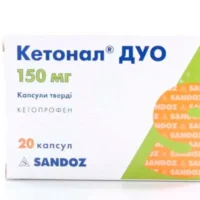Description
Indometacin Plus Ointment 40 g
Ingredients
- Indometacin
- Menthol
- Camphor
- Methyl Salicylate
Mechanism of Action
Indometacin works by inhibiting the enzyme cyclooxygenase, thereby reducing the synthesis of prostaglandins from arachidonic acid. Prostaglandins are mediators of inflammation, pain, and fever. By blocking their production, Indometacin Plus ointment effectively reduces pain and inflammation at the application site.
Pharmacological Properties
Indometacin possesses anti-inflammatory, analgesic, and antipyretic properties. It acts by inhibiting prostaglandin synthesis and modulating the body’s response to various inflammatory stimuli.
Indications for Use
Indometacin Plus ointment is indicated for the symptomatic relief of pain and inflammation associated with musculoskeletal disorders such as rheumatoid arthritis, osteoarthritis, and sports injuries.
Contraindications
Avoid using Indometacin Plus ointment if you have a history of hypersensitivity reactions to NSAIDs (nonsteroidal anti-inflammatory drugs) or any of the components in the formulation. It is contraindicated in patients with active peptic ulcers, severe heart failure, and renal impairment. Do not apply to open wounds, mucous membranes, or areas with dermatitis.
Side Effects
Common side effects of Indometacin Plus ointment may include skin irritation, burning sensation, or allergic dermatitis. In rare cases, systemic absorption can lead to gastrointestinal disturbances or hypersensitivity reactions. Discontinue use if any adverse effects occur and seek medical advice.
Usage Instructions
Apply a thin layer of Indometacin Plus ointment to the affected area up to 3-4 times daily, following thorough cleansing and drying of the skin. Gently massage the ointment into the skin until fully absorbed. Wash hands after application to prevent accidental contact with eyes or mucous membranes.
Benefits Compared to Analogues
Clinical studies have demonstrated the superior efficacy of Indometacin Plus ointment in reducing pain, swelling, and improving joint mobility compared to standard NSAID formulations. Its targeted mechanism of action and optimized formulation offer enhanced pain relief and faster recovery in musculoskeletal conditions.
Suitable Patient Groups
Indometacin Plus ointment is suitable for adult and elderly patients with chronic musculoskeletal conditions requiring localized pain management. It is not recommended for use in children without medical supervision.
Storage Conditions and Shelf Life
Store Indometacin Plus ointment in a cool, dry place below 25°C, protected from light and moisture. Do not refrigerate or freeze. Check the expiration date on the packaging and discard any expired product. The shelf life of the ointment is typically 2 years from the manufacturing date.
Packaging Description
Indometacin Plus ointment is supplied in a 40 g aluminum tube with a screw cap for easy application and secure storage. The packaging is designed to maintain the stability and integrity of the product throughout its shelf life.





